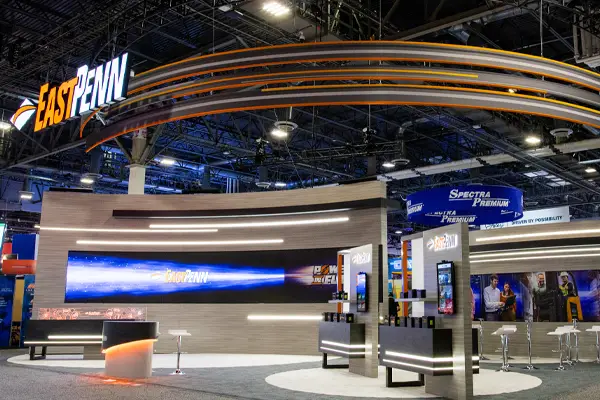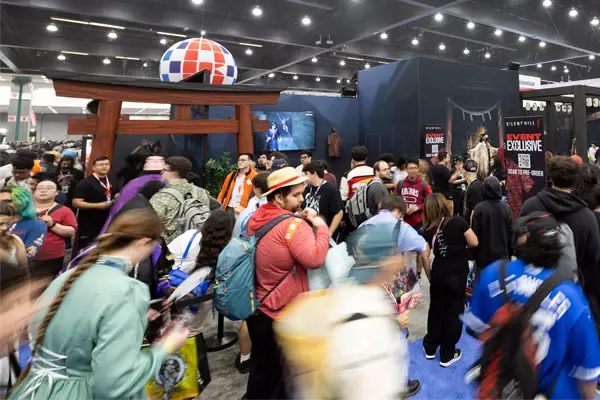[hubspot type=cta portal=20503845 id=786ce61c-d305-4b87-97f1-924377a4a52e]
Trade shows have been a staple of human enterprise for a long time.
From Middle Eastern bazaars to world fairs, large convention halls and exhibitions, the practice of selling and buying is essential to human flourishing. But the value of trade extends far beyond exchanging goods and services. It brings cultures together, strengthens community, and enlightens minds.
Today, there is a trade show for everything. Concrete. Orthopedic surgeons. Cybersecurity. Funeral directing. And while the current event industry was disrupted because of a pandemic, there is no sign that large community building trade shows are going to be swept under the rug. Most research projections from the Center of Exhibition Industry Research (CEIR) and Epistemix predict the trade show industry will make a full recovery by early 2024.
In the meantime, many businesses and event planners are rethinking traditional shows, searching for more efficient ways to facilitate trade while keeping a sense of community intact.
The Elephant in the Exhibit Hall
Even before the pandemic, executives and upper management were questioning the cost of exhibiting and ROI. Large corporations that excel in online markets benefited from the lockdowns and travel restrictions. For some, it was their best year. So why go back to the exhibit hall? It’s a fair question.
The cost of exhibiting can be steep. This is because there is more that goes into preparing for a show than simply reserving a spot on the floor. There’s also staffing, hotel and food reservations, flight tickets, booth design, installation and dismantling, and, finally, shipping. With costs easily exceeding tens of thousands of dollars, does the return justify the expense? The hard answer is… it depends.
It depends on two things:
Your industry and market level
Suppose you’re not a large corporation or you do not excel in the online market. If you are in the mid-market to low-market range, attending a trade show may still make a lot of sense–maybe more now than ever before. The recent Consumer Electronics Show (CES) is a good example.
In previous years, Big Tech companies like Amazon and Apple cast a disproportionate shadow over the event. However, this year they decided to sit out on the U.S’s largest trade show, giving smaller tech businesses the stage to shine on. And they did. You can read more about their experience here.
[adguru adid="4635"]
You should also consider your industry. For example, CES has a diverse audience, the majority of which can thrive in the digital realm. This fact manifested itself in lower attendance at this year’s show. However, consider the audience of say, a SHOT show or World of Concrete, and interacting face to face becomes more essential because of the need to vet potential partners and manufacturers is greater.
How you calculate ROI
Calculating ROI has always been a pain point for marketers. So much so, there is a movement to change the focus from return on investment (ROI) to return on objective (ROO). The basic argument is that marketing’s main purpose is to generate leads and then hand them off to sales. From that point on, marketing is not responsible for what happens. If a poor ROI results, it may not be the marketing team's fault. The problem could lie elsewhere.
But rather than shifting the blame (it could be just as likely that the leads marketing handed off were unqualified), you should try to prove your worth through a variety of means with as much data and evidence available. For example, there is much more value in trade shows than simply increasing revenue, such as the promotional value in the form of brand awareness, impressions, and social media follows.
[hubspot type=cta portal=20503845 id=4b793ac3-dd4a-4b04-8a9d-d24ec93291d7]
The New Emerging Exhibit Hall
So then, determining whether trade shows are worth the investment or not is dependent on a variety of factors from your industry, market level, and past ROIs. However, there is a new variable to consider: trade shows themselves are evolving. They are offering new ways to reach your audience and connect with clients, investors, and partners. We have followed these developments closely, and a good place to start is our video review of MRO Americas 2021.
The Hybrid Event
The pandemic did not necessarily create new trends–it accelerated the trajectory of existing trends. Think of remote work or video streaming. The same is true of trade shows. 2021 saw many shows incorporate many digital extensions of the show, from live streaming keynote speakers to a full on virtual tour of the exhibit hall. NPE East is a good example of these media extensions.
Virtual Trade Shows
Virtual-only shows have mixed reviews. CES was the first large event to go completely virtual in 2021. The number one thing people said was missing was the trade show elements of face to face connection and networking. While the actual operations and strategy for virtual events still needs to be worked out, don’t discount it entirely.
New Exhibit Designs
As solutions are brought up on how to maintain engagement post-pandemic, there are bold leaders attempting to reimagine the exhibit hall. But event planners aren’t the only ones innovating. Trade show companies are reimagining traditional displays to adapt to the changing landscape. Booth designs are catching up with the changing landscape.
Interactive Virtual Exhibits
An interactive virtual exhibit is a digital extension of your physical trade show booth. Essentially, it’s an interactive image of a 3D exhibit. They are becoming a useful tool for physical trade shows as they help you reach members of your audience who are not attending in-person. They can also be used in email marketing campaigns, and remain active much longer than physical displays.
Automated Booths
Automated booths are helping cut costs on the need for physically present staff. LG at the recent CES show used an automated booth. They filled their empty space with different hubs that had QR codes which contained different content, connecting attendees with their digital presence in a physical way.
[hubspot type=cta portal=20503845 id=786ce61c-d305-4b87-97f1-924377a4a52e]
Conclusion
Much is still in the air for trade shows. The overall consensus appears to be that many people want to keep the traditional trade show because of its unrivaled benefits of networking and cost-effective lead gathering. But event planners are changing things up and the final result is yet to be see. What do you want to see happen at trade shows for 2022 and beyond?
The Trade Group is a full-service trade show and event marketing company. We will work with you to create an exhibit or an event that brings in leads and helps you achieve your business goals. Contact us here or give us a call at (800) 343-2005.

Cameron Wilkinson is a writer and editor based in Dallas, TX. His writing for the events industry pairs with his interests in sales and marketing. He also holds a B.A. in English Literature from the University of North Texas.








